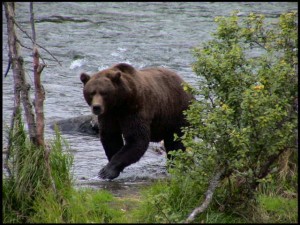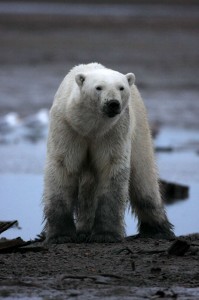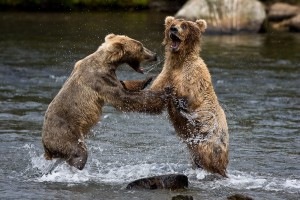BearWise Training April 26 & 27, 2012
By Ron Yarnell

With more than 40 years of guiding experience in grizzly country, I know a thing or two about bears, so when Marin Kuizenga, with Polar Field Services Inc, said she had room for three Arctic Wild guides in a bear safety workshop, I was a bit skeptical. I wasn’t sure if I wanted to spend a day and a half sitting indoors listening to lectures during our wonderful spring weather.
Boy, was I mistaken. First of all, Canadian Andy McMullen, with BearWise Inc. was the perfect person for the job. With over 35 years of living in the Canadian far north, (Yellowknife and farther north) guiding, running tourist camps, as a government employee, researcher, professional hunter and a whole lot more… Andy has done it all and seen it all…..from diamond mining camps to oil exploration rigs, Eskimo subsistence cabins to 1000-man half cities.
Most important, Andy is serious about what he does, training folks about bear safety. It became obvious immediately Andy was a professional and wanted us to learn that if we were having a problem with a bear, we were doing something wrong. Self-demeaning, with that wonderful Canadian wit, Andy kept us focused and kept us learning.
25 folks attended the class. We had Inupiat bear guards from Barrow, Greenland researchers from Denver, Polar Services people from here in Fairbanks, Bureau of Land Management Archeologists, University of Alaska Fairbanks field camp professors, NOLS & Arctic Wild guides.

The class covered bear identification (Black, Grizzly & Polar Bear), behavior, encounter types & responses, problem prevention and lastly deterrents. Andy’s emphasis on avoiding problems rather than using deterrents was refreshing for those of us who respect the fact that we are invading bear country, not the other way around. His use of traditional native knowledge about bears was a wonderful way of showing us how we could learn to live with bears and minimize our impact upon them.
Some of the things I learned from the class I already knew intuitively, but didn’t know how to express to our guests. For instance, is the approaching bear a defensive bear or a non-defensive bear? Did you enter its space so that it is defending itself, its young or a kill? Or is the bear acting predatory? The bear’s behavior can tell you immediately what kind of bear you are dealing with. All bears are talking to us, or giving us signals. In the vast majority of close encounters they are telling us to get out of their space. It is obvious to those of us who have traveled in bear country for years and encountered hundreds of bears, but not always so obvious to our guests. Learning to explain these signals to our guests can mean the difference between an enjoyable encounter and one with dramatically more negative results for both the bear and us.
The discussions on polar bears was the most interesting to me because each year we find ourselves doing more and more trips in polar bear country and, with global warming, we are finding more and more bears that are stranded on land that we are also using. Most important, we learned that polar bears really aren’t all that different, behavior wise, than other bears. In the vast majority of encounters, once they find out you are human, they are on their way, just like grizzlies and black bears. They are not the man-stalkers they have been made out to be.
In all cases when you run across a bear, any kind of bear, first of all you:
1) Stop
2) Assess the situation. Does the bear see you?
3) If not, back out the way you came. Let the bear go its own way. Avoid an encounter.
If the bear sees you:
1) Stop
2) Assess the situation. Is the bear acting defensive or predatory?
3) If either… start talking to the bear immediately. Let it know you are human.
4) Hold up your hands and talk in a casual manner.
5) Stand your ground if the bear approaches
6) Back up when bear stops.
7) If the bear is acting predatory increase your aggression. Holler louder. Jump up and down. Throw rocks or sticks. Defend yourself.

But the most important thing of all before encountering a bear is to BE OBSERVANT. See the bear before it sees you. Keep a clean camp. Cook away from camp. Safeguard your food. Don’t keep food or smelly items in your sleeping tent. Dispose of waste in a proper manner that will not attract bears or draw them to where you and others may camp. Remember…have RESPECT for the bears and for yourself. Avoid a problem by practicing good bear safety procedures. You don’t have to avoid bear country. Seeing bears, especially grizzlies and polar bears, can be one of the highlight of a trip to the arctic. This is part of what makes Alaska so unique. Enjoy the experience.


